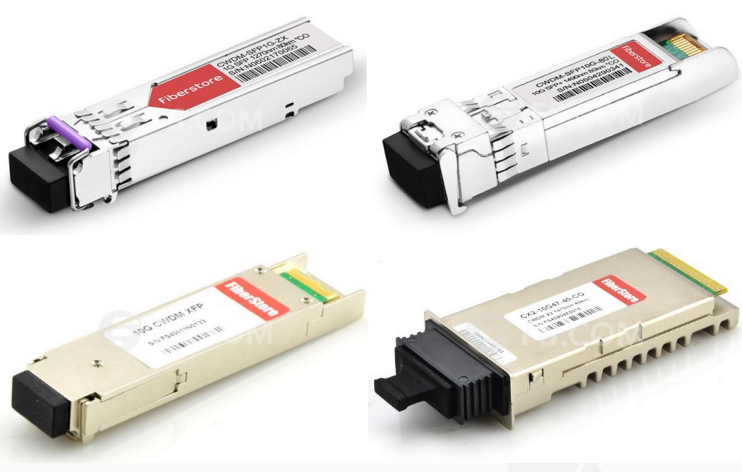It is easy to learn that CWDM stands for Coarse Wavelength Division Multiplexing, which belongs to one of WDM technologies. With the fast development and gradual maturity of WDM technologies, CWDM technology becomes popularly used in recent years that allows for expanding network capacity without more fibers and supporting less expensive and power consuming system. For all these advantages, CWDM technology is applied in many optical equipment. One of the most popular equipment that uses this technology is CWDM optical transceiver, which will be introduced in the following text.
CWDM transceiver is a kind of optical module typically working with CWDM technology, which is designed for connecting the existing network equipment with CWDM multiplexers/demultiplexers (Mux/Demux). As for its working principle, it is able to combine optical signals with different wavelengths in the multiplexers side and transmit the integrated signal through a single fiber, while splitting the integrated signal into several signals with different wavelengths in the demultiplexers side. And there are eighteen channels available in CWDM transceiver for transmitting signals with different wavelengths from 1270 nm to 1610 nm, such as 1270 nm, 1290 nm, 1310 nm, 1330 nm, etc.
At present, CWDM transceiver can be simply divided into four types, CWDM SFP, CWDM SFP+, CWDM XFP and CWDM X2, both of which will be studied in details. Besides, to better know CWDM transceivers, here offers the figure for the appearance of the four CWDM transceivers for your reference.

CWDM SFP is a kind of hot-pluggable optical module, which is SFP MSA (Multi Sourcing Agreement) and IEEE 802.3 & ROHS compliant. Compared to other CWDM transceivers, CWDM SFP is the most commonly used module that connects LC duplex single-mode patch cord to support 1G, 2G and 4G Ethernet network at lengths up to 200 km. In its working process, it enables the network capacity to be increased by transmitting multiple data through a single fiber, with the function of combining optical signals with different wavelength into an integrated signal.
As for the application, CWDM SFP can support the CWDM passive optical system combing CWDM OADM (optical add/drop multiplexer). If you use CWDM SFP to work with transponders and media converters, you will find that the two optical components convert the existing equipment with standard wavelengths or copper ports to CWDM wavelengths in a very convenient way.
CWDM SFP+ is an upgraded version of CWDM SFP that offers a simple way to make 10G network connection. It has the ability to work with up to eight channels for transmitting 10G signals at the wavelengths including 1470 nm, 1490 nm, 1510 nm, 1530 nm, 1550 nm, 1570 nm, 1590nm, and 1610 nm, through single-mode fiber strands. And it can be used in parallel with other SFP+ devices on the same platform.
In contrast to CWDM SFP, it is much more expensive. However, taking 10G Ethernet applications into consideration, CWDM SFP+ is really a cost-effective solution in campus, data center and metropolitan area access networks. After all, it allows for increasing the bandwidth of an existing 10G Ethernet optical infrastructure without adding new fiber strands.
Just like CWDM SFP+, CWDM XFP is also used for 10G Ethernet applications with Z-direction design, which complies with CWDM XFP MSA. What’s about the cost? It is also nearly the same as that of CWDM SFP+. Meanwhile, it can transmit 10G signals at the distance up to 100 km, which depends on the wavelengths, fiber types and the CWDM Mux/DeMux insertion loss. Besides, it is mainly used in Storage, IP network and LAN applications, working with the wavelengths from 1270 nm to 1610 nm.
In comparison with the previous three CWDM transceivers, CWDM X2 is the most expensive one which is suitable for CWDM optical data communications like 10G Ethernet and 10G Fibre Channel applications. Similar to CWDM XFP, it also works with the wavelengths from 1270 nm to 1610 nm, supporting 10G transmission at lengths up to 80 km over SC duplex single-mode fiber cable.
CWDM transceivers can greatly expand the network capacity without additional fibers by connecting the existing network equipment with CWDM multiplexers/demultiplexers (Mux/Demux). It is really a cost effective solution for higher capacity that allows for a highly flexible and available multi-service network. As for the four kinds of CWDM transceivers mentioned above, you can choose the proper one according to their features and your existing network need.









